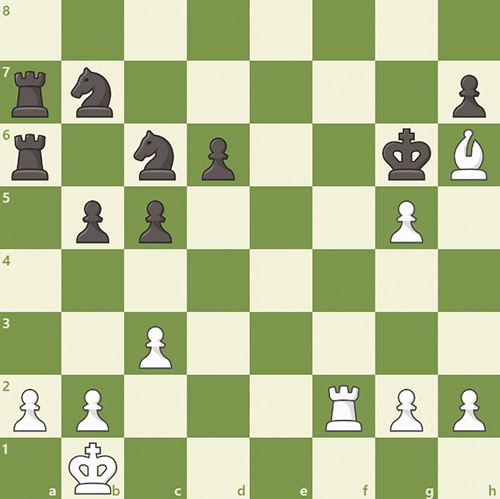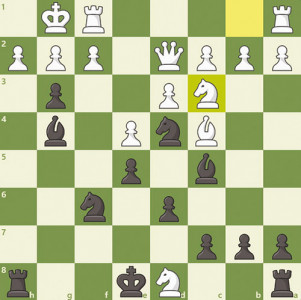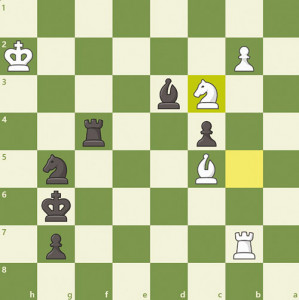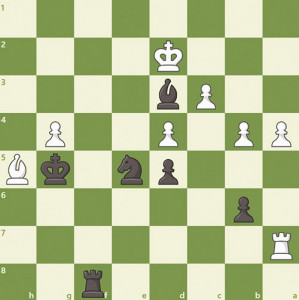
In chess, a Mating Net is the concept of using one’s pieces to constrain the movement of the opponent’s king and prevent it from escaping a checkmating attack. Figure 1 exemplifies the power of this idea through a position where black is up 6 points of material but white is able to checkmate black by force in two moves. While white is close to being able to deliver a checkmate, if white were to play rook to f6 check immediately, defended by the pawn on g5, the black king can simply escape to the h5 square. Therefore, the only move that wins for white is pawn to g4, creating a mating net around the black king by preventing it from going to the h5 square. After this black has no moves that can prevent white from playing Rook to f6 checkmate on the next move, as none of its pieces can defend and the king has no legal moves, rendering it helpless to the white rook.
Unlike previous columns, this edition’s game analysis will actually start from the beginning of the game as it is relatively short but very exciting nonetheless; Figure 2 is a position towards the end of the game and you can try and find black’s only winning move before reading the analysis. Russian astronomer and chess player Victor Knorre had the white pieces against Mikhail Chigorin, a world-class Russian chess player.

The game began with: 1. e4 e5 2. Nf3 Nc6 3. Bc4 Bc5, the Giucco Piano variation of the Italian Game, one of the most popular openings with e4. 4. 0-0 Nf6 5. d3 d6 and the players continue to develop naturally and further defend their positions. After 6. Bg5 h6 7. Bh4 g5, the game greatly intensifies as Chigorin shoves forward his kingside pawns to kick out the bishop, a strong idea that often can result in kingside weaknesses for black. 8. Bg3 h5 and black makes his intentions of launching an early attack against white’s king very clear as he sacrifices the g5 pawn to open the g file and prepares to use the h pawn to pry open the king’s defenses. 9. Nxg5, although it looks viable because of Nxf7 forking the queen and rook, it is actually white’s first mistake as it allows Chigorin to further attack the king by sacrificing some of his own pieces. 9… h4, trapping the bishop, 10. Nxf7 and here Chigorin executed a brilliant attacking idea with the move 10… hxg3, sacrificing his queen with the understanding that, even though he loses material, the white king is left bereft of sufficient defense against black’s rook, bishops, knight and g pawn. 11. Nxd8 Bg4 12. Qd2 Nd4 13. Nc3, reaching the position shown in Figure 2, and here Chigorin found the only winning move that creates a mating net around the white king, trapping it from escaping the onslaught of black pieces and forcing checkmate in 7 moves. Black played 13. Nf3+, sacrificing the knight so that after 14. gxf3 Bxf3, white cannot ultimately prevent either gxh2 or Ra1, checkmating the white king. Therefore, Knorre resigned after Bxf3.
Figure 3 is a position from a game between Super-Grandmaster Hikaru Nakamura with the black pieces against Grandmaster Judit Polgar, the strongest women player of all time, with white, at the London Chess Classic of 2012. Here, the winning move for black is the quiet Rook to g4, constraining the white king to the h file and checkmate is unstoppable without major loss of material. In the game, Polgar played Knight to d1, which allows another quiet move for black that forces checkmate in five moves: Bishop to f1, which further weaves a mating net around the white king, covering h3 so the knight can move and not give up control of the square. Polgar resigned in this position because she could not prevent Nakamura from placing his knight on f3, forcing the king to h1 and covering the g1 square, and then checkmating with Rook to h4. This idea is demonstrated in the line after Bf1: 12. Rb6+ Kh5 13. Rb3 cxb3 14. Kh1 Nf3 15. Nf2 Bg2#
The position shown in Figure 4 is from a game the URS-ch in the 1950s between Nikolay Bakulin, with white, against Grandmaster Viktor Korchnoi, with black. Here, the winning move is Knight to c4 check, sacrificing the Bishop on d3 to create a mating net around the black king (the idea still works after 1… Rf2+ 2. Ke1 Rf1+ 3. Kd2). After the white king takes the Bishop on d3, Black then plays Rook to f2, trapping the white king and preparing the unstoppable Rook to d2 checkmate. While white can delay the inevitable with Rook to g7 check, black simply plays King to h4 and then Rook to d2, regardless of what white does, checkmating the helpless white king.

Ethan Feder is a junior at Yeshivat Frisch, a chess enthusiast and player. The goal of his column is to teach and discuss chess concepts through example positions, high-level games and relevant puzzles, along with explanations. Feel free to contact him with any questions, suggestions or comments at [email protected].











